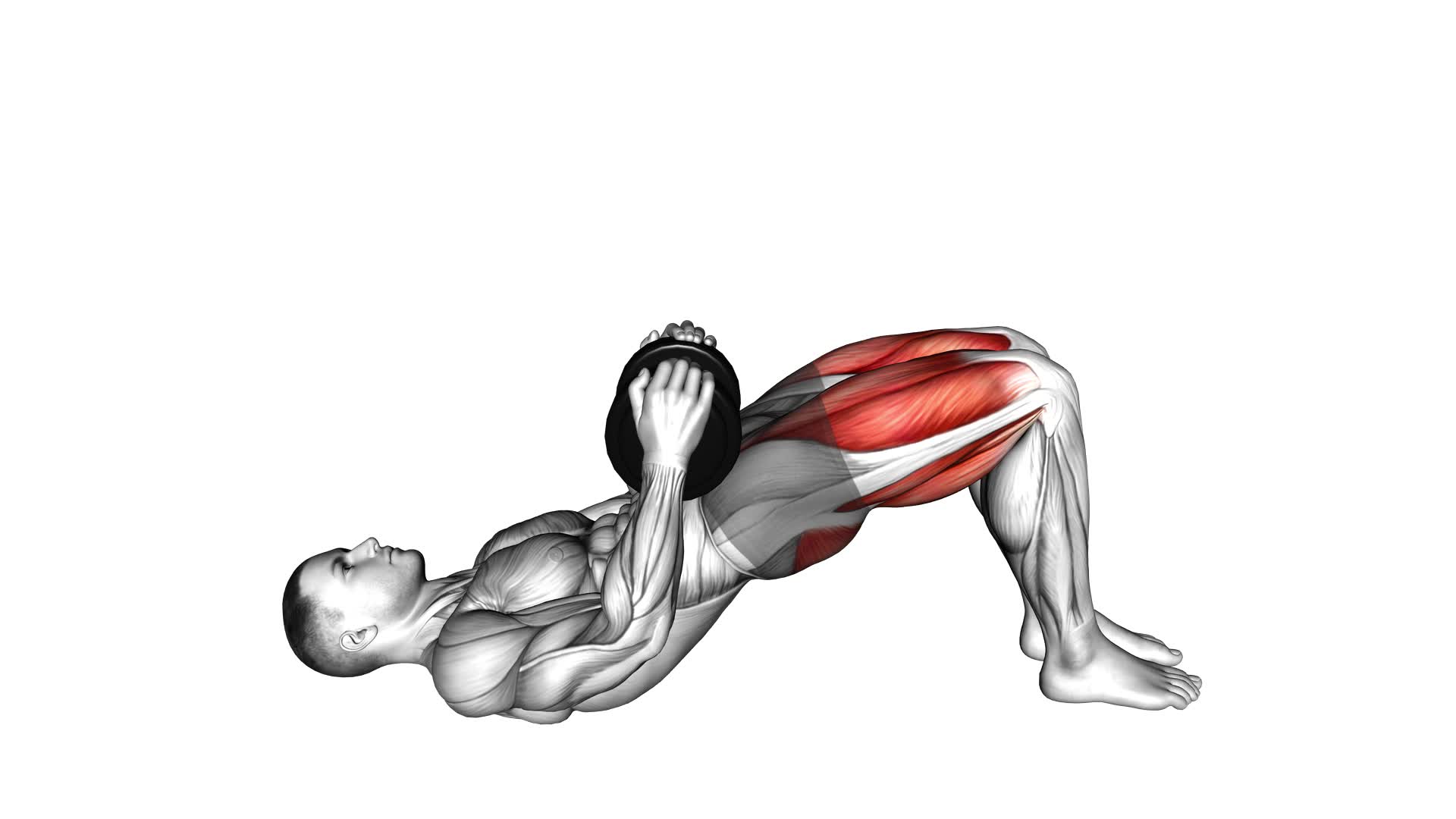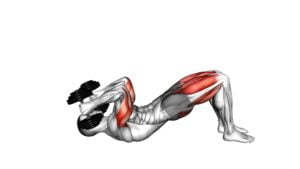Dumbbell Glute Bridge – Video Exercise Guide & Tips

Looking to strengthen your glutes and improve your overall lower body strength? The dumbbell glute bridge is a fantastic exercise that targets your glute muscles while also engaging your core.
Watch This Exercise Video
In this video exercise guide, you'll learn the proper form and technique, as well as variations to challenge yourself.
Get the most out of your workout by following these tips and avoiding common mistakes.
Let's get started on sculpting those glutes!
Key Takeaways
- The dumbbell glute bridge activates the muscles in the hips, promoting stability and strength.
- It is important for athletes and individuals who participate in activities that require explosive lower body movements.
- The exercise helps develop strong, powerful glutes and improves overall lower body strength.
- Incorporating variations and progressions of the dumbbell glute bridge can further intensify the exercise and target different muscle groups.
Benefits of the Dumbbell Glute Bridge
The dumbbell glute bridge offers numerous benefits for those looking to strengthen their glutes and improve overall lower body strength. One of the key benefits is the activation of the hips. By lifting your hips off the ground and squeezing your glutes at the top of the movement, you engage the muscles in your hips, promoting stability and strength. This is especially important for athletes and individuals who participate in activities that require explosive lower body movements, such as running or jumping.
Another benefit of the dumbbell glute bridge is its ability to be progressed. Once you have mastered the basic movement, you can increase the difficulty by adding weight to the exercise. Holding a dumbbell on your hips or using a barbell across your pelvis challenges your glutes and forces them to work harder to lift the weight. You can also progress the exercise by elevating your feet on a bench or stability ball, which increases the range of motion and further activates your glutes.
Incorporating the dumbbell glute bridge into your workouts can help you develop strong, powerful glutes and improve your overall lower body strength. Remember to focus on hip activation and continuously challenge yourself by progressing the exercise.
Proper Form and Technique
To perform the dumbbell glute bridge with proper form and technique, start by lying on your back with your knees bent and feet flat on the ground. Place a dumbbell on your hips, holding it securely with both hands. Keep your arms straight and your palms facing down.
One common misconception about the dumbbell glute bridge is that you should lift your hips as high as possible. However, it's important to focus on engaging your glutes and maintaining a straight line from your knees to your shoulders. Avoid hyperextending your lower back or arching too much.
As you lift your hips, exhale and squeeze your glutes at the top of the movement. Make sure to engage your core and keep your abs tight throughout the exercise. Hold the position for a moment before slowly lowering your hips back down to the starting position.
Another common misconception is that you should only use heavy weights for this exercise. While adding weight can increase the challenge, it's important to start with a weight that allows you to maintain proper form. Gradually increase the weight as you become stronger and more comfortable with the exercise.
Remember to breathe throughout the movement and focus on using your glutes to lift your hips. With proper form and technique, the dumbbell glute bridge can be an effective exercise for strengthening and toning your glutes.
Variations to Challenge Your Glutes
Looking to take your glute bridge to the next level? There are advanced modifications and variations that can challenge your glutes even more. These variations not only increase the difficulty of the exercise but also help activate your glute muscles more effectively.
One advanced modification is the single-leg glute bridge. Instead of using both legs to lift your hips, lift one leg off the ground and perform the exercise with just one leg. This variation increases the demand on your glutes and forces them to work harder to stabilize your body.
Another variation is the weighted glute bridge. Hold a dumbbell, kettlebell, or barbell across your hips as you perform the exercise. The added weight increases the resistance and makes your glutes work harder to lift your hips.
You can also try the elevated glute bridge. Place your feet on an elevated surface, such as a bench or step, to increase the range of motion and target your glutes from a different angle.
Incorporating these advanced modifications and variations into your glute bridge routine will help you challenge your glutes and achieve greater strength and activation in this muscle group. Remember to always maintain proper form and technique to prevent injury and maximize the effectiveness of the exercise.
Tips for Getting the Most Out of Your Workout
To maximize your workout, make sure you focus on proper form and technique. Here are three tips to help you get the most out of your workout:
- Incorporate resistance bands:
Resistance bands are a great way to increase the intensity of your workout. By adding resistance to your exercises, you challenge your muscles even more, leading to increased strength and muscle growth. You can use resistance bands in various exercises, such as squats, lunges, and glute bridges. Simply place the band around your legs or arms and perform the exercise as usual, feeling the added resistance.
- Increase the intensity gradually:
It's important to gradually increase the intensity of your workouts to avoid injury and ensure progress. Start with lighter weights or lower resistance bands and gradually increase the load or resistance as your strength improves. This progressive overload helps to stimulate muscle growth and prevent plateaus.
- Focus on mind-muscle connection:
When performing exercises, focus on the muscles you're targeting. This mind-muscle connection can help you engage the targeted muscles more effectively, leading to better results. For example, when doing glute bridges, concentrate on squeezing your glutes at the top of the movement. This will maximize the activation of your glute muscles and enhance their development.
Common Mistakes to Avoid
Avoid these common mistakes to get the most out of your dumbbell glute bridge exercise. Making these errors can prevent you from targeting your glutes effectively and may lead to injury.
One common mistake to avoid is using too much weight. While it may be tempting to load up on heavy dumbbells, using excessive weight can compromise your form and put unnecessary strain on your lower back. Start with a weight that allows you to maintain proper form throughout the exercise.
Another common error isn't engaging your glutes properly. To maximize the effectiveness of the glute bridge, focus on squeezing your glutes at the top of the movement. This will ensure that you're activating the correct muscles and getting the most out of each rep. Additionally, avoid lifting your hips too high or too low. Lifting too high can strain your lower back, while lifting too low can reduce the effectiveness of the exercise. Aim to lift your hips until your body forms a straight line from your knees to your shoulders.
Lastly, rushing through the exercise is another mistake to avoid. Take your time and perform each rep with control and intention. This will maximize muscle activation and prevent any jerky or uncontrolled movements that may lead to injury.
Frequently Asked Questions
How Many Sets and Reps Should I Do for the Dumbbell Glute Bridge?
To determine the number of sets and reps for the dumbbell glute bridge, it's important to consider your fitness goals and current strength level. Start with 2-3 sets of 10-15 reps and gradually increase as you get stronger.
If you have lower back pain, try modifications like placing a towel or yoga block under your hips for support.
Incorporating dumbbells in the exercise adds resistance and targets your glutes even more.
This exercise can also be integrated into a cardio routine or combined with other glute-enhancing exercises for a complete workout.
Can I Do the Dumbbell Glute Bridge if I Have Lower Back Pain?
Yes, you can modify the dumbbell glute bridge if you have lower back pain. By using lighter weights or no weights at all, you can still engage your glutes without putting too much strain on your lower back.
Additionally, the dumbbell glute bridge can actually help relieve lower back pain by strengthening your glutes and core muscles.
Remember to listen to your body and consult with a professional if you have any concerns or persistent pain.
Is It Necessary to Use Dumbbells for the Glute Bridge Exercise?
Using dumbbells for the glute bridge exercise isn't necessary, but it can bring added benefits.
Adding weights to the glute bridge helps increase the intensity, making the exercise more challenging and effective in building strength and muscle.
The extra resistance from the dumbbells also targets the glutes and hamstrings even more, helping to shape and tone those muscles.
Can I Incorporate the Dumbbell Glute Bridge Into My Cardio Routine?
Yes, you can definitely incorporate the dumbbell glute bridge into your cardio routine. By adding dumbbells to the glute bridge exercise, you increase the resistance and intensity, which can help to build strength and improve your cardiovascular fitness.
However, if you prefer not to use dumbbells, there are alternative glute exercises that can also provide cardiovascular benefits, such as the hip thrust or the single-leg glute bridge.
What Are Some Other Exercises That Complement the Dumbbell Glute Bridge for a Complete Glute Workout?
To complement the dumbbell glute bridge for a complete glute workout, you can try hip thrust variations and Bulgarian split squats. These exercises target different muscles in your glutes and help enhance strength and stability.
Hip thrust variations, like barbell hip thrusts or single-leg hip thrusts, can isolate and activate the glute muscles effectively.
Bulgarian split squats, on the other hand, engage your glutes while also targeting your quads and hamstrings.
Incorporating these exercises can add variety and challenge to your glute training routine.
Conclusion
In conclusion, the dumbbell glute bridge is an effective exercise for targeting and strengthening the glute muscles. By maintaining proper form and technique, you can maximize the benefits of this exercise.
Additionally, incorporating variations into your routine can help challenge your glutes even further. Remember to follow the tips provided to get the most out of your workout and avoid common mistakes.
Keep practicing and enjoy the results of a stronger and more toned gluteal area.

Author
Years ago, the spark of my life’s passion ignited in my mind the moment I stepped into the local gym for the first time. The inaugural bead of perspiration, the initial endeavor, the very first surge of endorphins, and a sense of pride that washed over me post-workout marked the beginning of my deep-seated interest in strength sports, fitness, and sports nutrition. This very curiosity blossomed rapidly into a profound fascination, propelling me to earn a Master’s degree in Physical Education from the Academy of Physical Education in Krakow, followed by a Sports Manager diploma from the Jagiellonian University. My journey of growth led me to gain more specialized qualifications, such as being a certified personal trainer with a focus on sports dietetics, a lifeguard, and an instructor for wellness and corrective gymnastics. Theoretical knowledge paired seamlessly with practical experience, reinforcing my belief that the transformation of individuals under my guidance was also a reflection of my personal growth. This belief holds true even today. Each day, I strive to push the boundaries and explore new realms. These realms gently elevate me to greater heights. The unique combination of passion for my field and the continuous quest for growth fuels my drive to break new ground.







